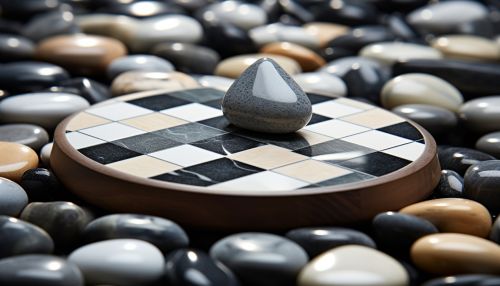Go (game)
History
Go is an abstract strategy board game for two players, in which the aim is to surround more territory than the opponent. The game was invented in China more than 2,500 years ago and is believed to be the oldest board game continuously played to the present day. Ancient Chinese books note that the game was often used as a tool for teaching military strategy, and was considered one of the four essential arts of a cultured Chinese scholar.
The game reached Japan in the 7th century, Korea in the 8th century, and the rest of the world in the 19th century. It is now popular worldwide, with an estimated 40 million players, primarily in East Asia.


Gameplay
The game is played on a grid of black lines (usually 19×19). Game pieces, called stones, are played on the lines' intersections. The stones are usually black and white, representing two players. Once placed on the board, stones cannot be moved unless they are surrounded and captured by the opponent's stones.
The game proceeds by players alternately placing one stone on an empty intersection. The objective of the game is to use one's stones to form territories by surrounding vacant areas of the board. Players strive to serve dual purposes: one is to make one's own formation while the other is to prevent the opponent from doing the same.
Rules
There are essentially only two rules in Go:
1. Rule of Liberty: Every stone remaining on the board must have at least one open "point" (an intersection, called a "liberty") directly orthogonally adjacent (up, down, left, or right), or must be part of a connected group that has at least one such open point ("liberty") next to it. Stones or groups of stones which lose their last liberty are removed from the game (captured).
2. Rule of Ko: A player may not place a stone such that it or its group immediately has no liberties, unless doing so immediately deprives an enemy group of its final liberty. In the latter case, the enemy group is captured, leaving the new stone with at least one liberty.
Strategy and Tactics
The game emphasizes the importance of balance on multiple levels, and this principle of balance is applied to the fight for territory and in capturing races, the framework of game play. The game provides a rich set of complex strategies and tactics, all of which rely on the fundamental principle of balance.
Go and Mathematics
There is a significant amount of research into software for playing Go, as it represents an interesting problem for artificial intelligence and machine learning. The number of legal board positions in Go is vast, greatly exceeding the number of atoms in the universe. Therefore, unlike in chess, it is considered impossible to solve Go purely through brute force computation.
Go in Popular Culture
Go has made its way into popular culture, with mentions and depictions in various works of fiction, from novels to television shows. The game is often used as a metaphor for complex political and military strategies.
